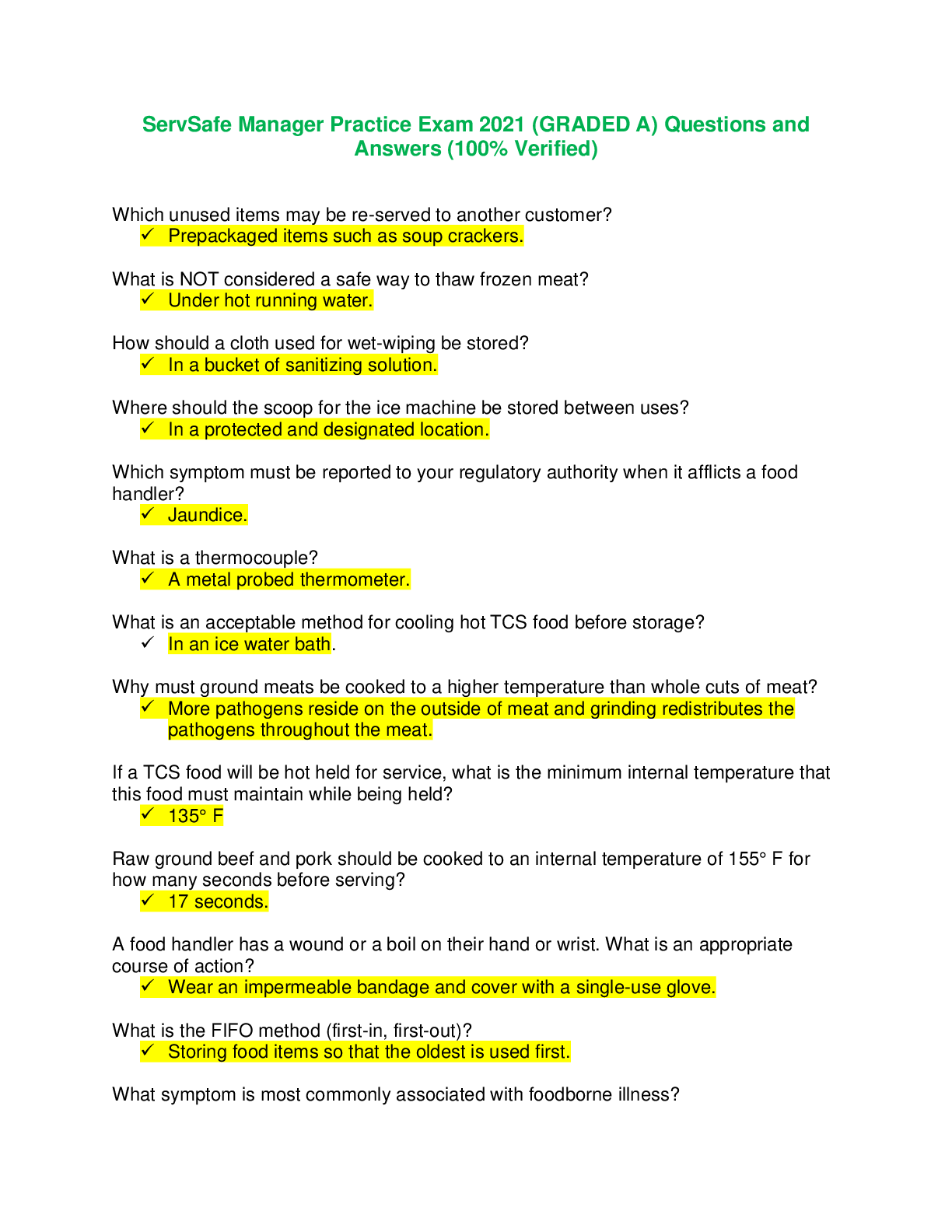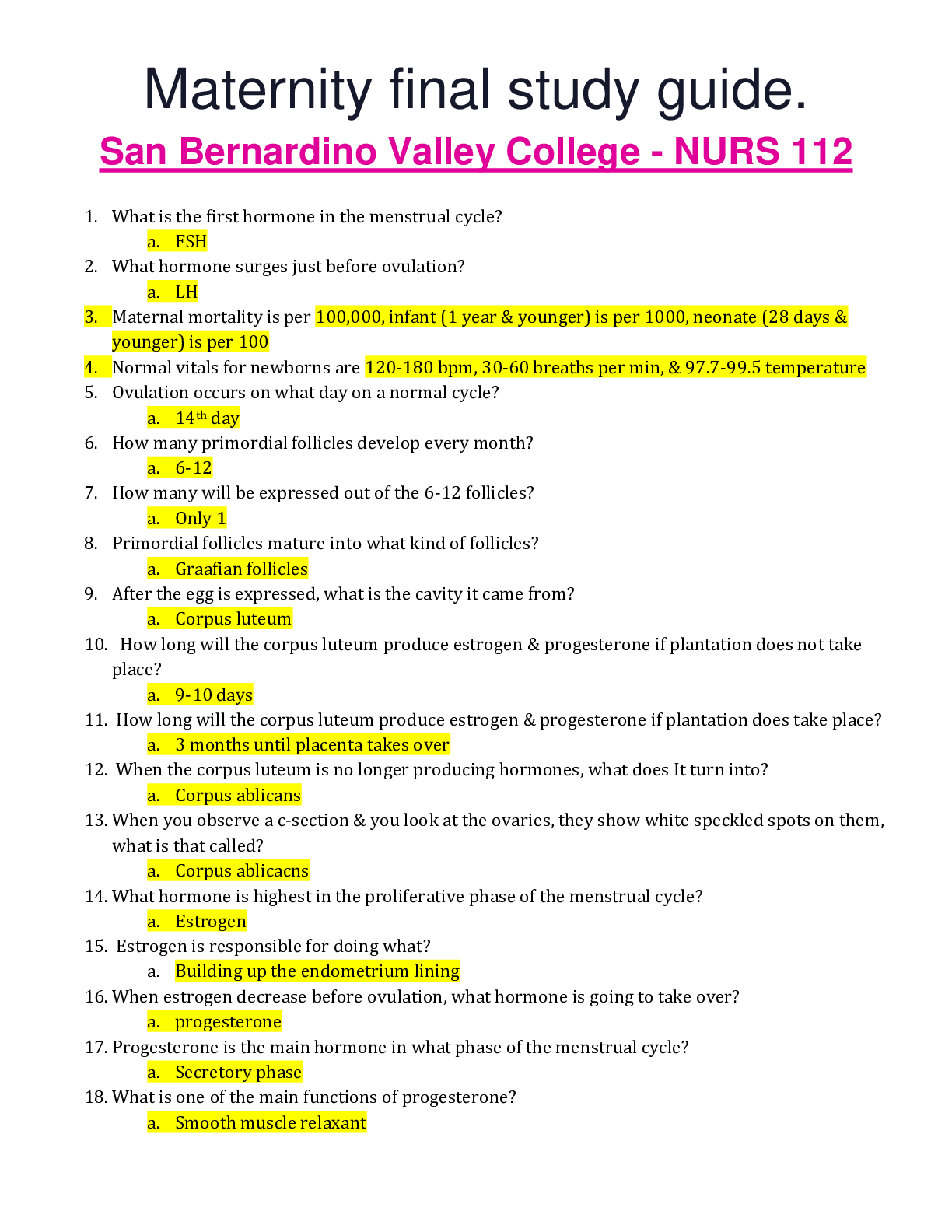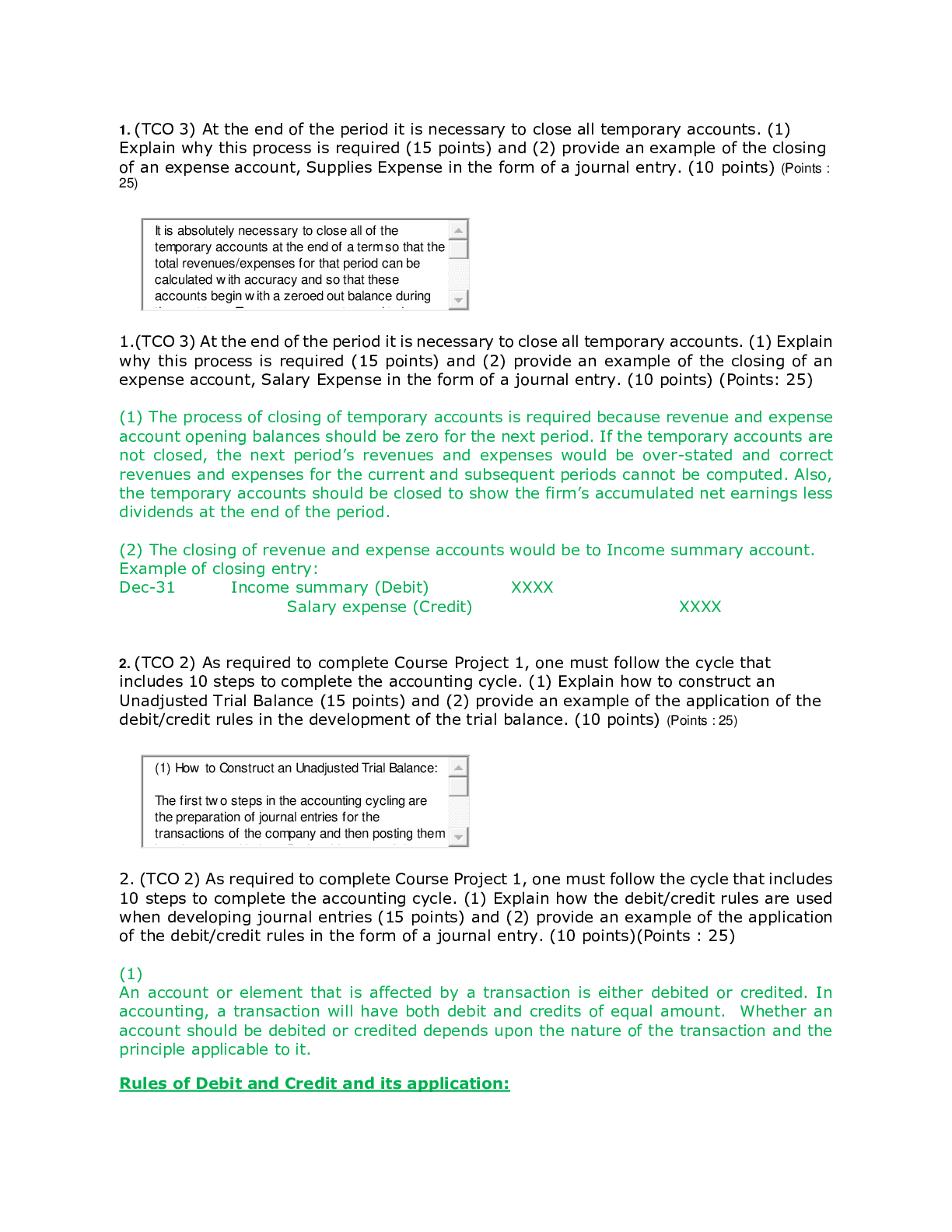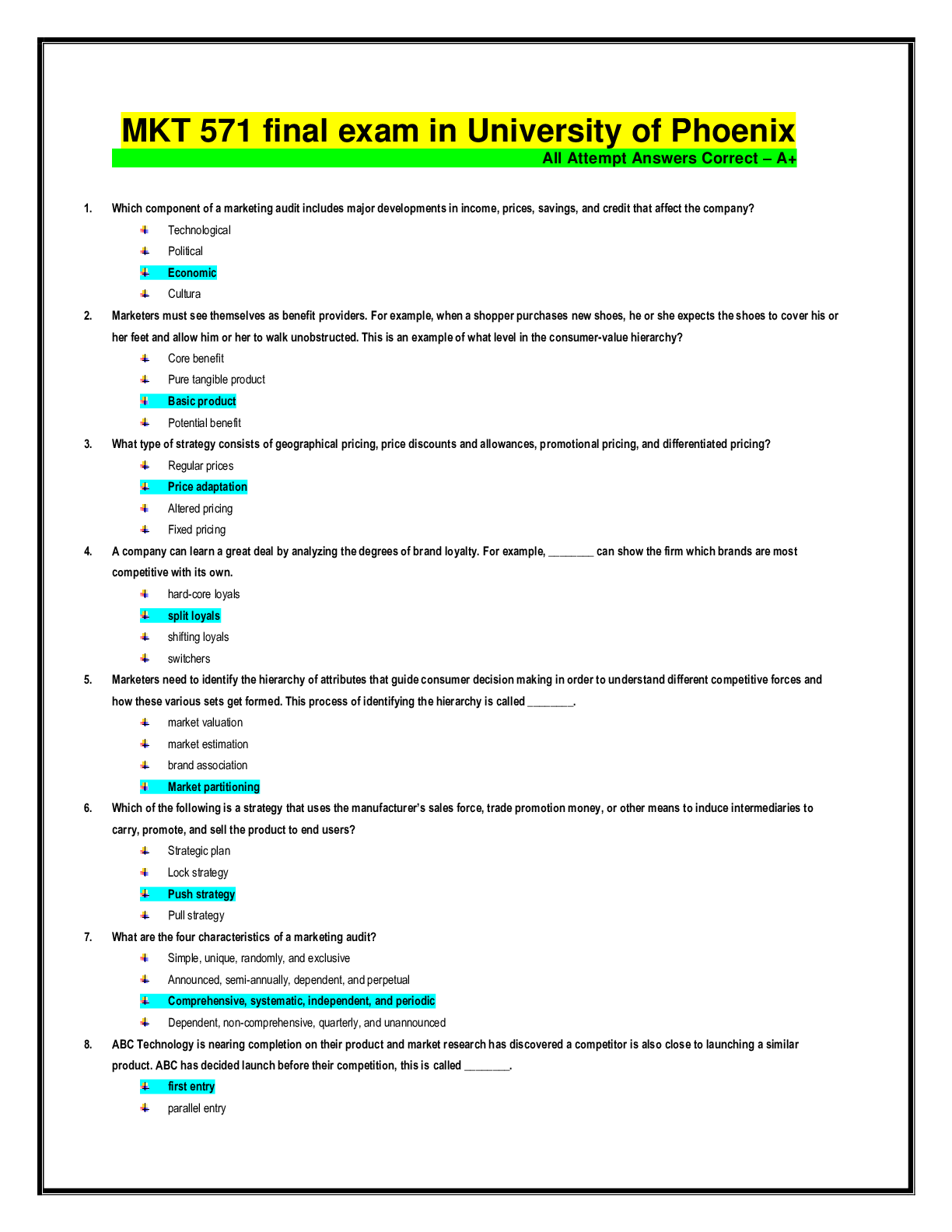*NURSING > EXAM > PALSPALS Review Questions & Answers (Latest Update) Exam (100% Verified Answers) (All)
PALSPALS Review Questions & Answers (Latest Update) Exam (100% Verified Answers)
Document Content and Description Below
PALS:PALS Review Questions & Answers (Latest Update) Exam (100% Verified Answers) The most determining factor in relation to a child's cardiac output is the? Heart rate The most determining f... actor in relation to a child's cardiac output is the? Heart rate What pharmacologic intervention in the presence of anaphylactic shock has almost no immediate benefit? Corticosteroids. What pharmacologic intervention in the presence of anaphylactic shock has almost no immediate benefit? Corticosteroids. What side effect is not commonly associated with the administration of albuterol? Bradycardia. What side effect is not commonly associated with the administration of albuterol? Bradycardia. When performing a pulse check in a child, the provider should? palpate the carotid pulse ( brachial artery in infants). When performing a pulse check in a child, the provider should? palpate the carotid pulse ( brachial artery in infants). The grunting sound heard in many lower airway diseases is caused by? air pushing up against the glottis. The grunting sound heard in many lower airway diseases is caused by? air pushing up against the glottis. The most common type of shock in children worldwide is? hypovolemic shock. The most common type of shock in children worldwide is? hypovolemic shock. The most common cause of nonsinus tachycardia in children is? accessory pathway SVT. The most common cause of nonsinus tachycardia in children is? accessory pathway SVT. The most common cause of acute cardiogenic pulmonary edema is? CHF. The most common cause of acute cardiogenic pulmonary edema is? CHF. You are doing CPR on a child with bradycardia. An intravenous line is in place. What is the first drug of choice for the patient? Epinephrine 0.01 mg/kg of 1:10000 concentration every 3 to 5 minutes You are doing CPR on a child with bradycardia. An intravenous line is in place. What is the first drug of choice for the patient? Epinephrine 0.01 mg/kg of 1:10000 concentration every 3 to 5 minutes You are on a resuscitation team caring for an 8 year old child. You know that the normal resting heart rate HIGH for a child of this age is? 140 You are on a resuscitation team caring for an 8 year old child. You know that the normal resting heart rate HIGH for a child of this age is? 140 Your pediatric patient is in septic shock with vasodilated (warm) shock. Pt received multiple fluid boluses and continues to be hypotensive. The vasoactive drug of choice is? Norepinephrine (0.1 to 2mcg/kg/min) Your pediatric patient is in septic shock with vasodilated (warm) shock. Pt received multiple fluid boluses and continues to be hypotensive. The vasoactive drug of choice is? Norepinephrine (0.1 to 2mcg/kg/min) A 10 year-old child is brought to the ED with a systolic blood pressure of 100, a heart rate of 110, slightly delayed capillary refill and cool, pale skin. You suspect that the child is in ______ shock ? Compensated shock A 10 year-old child is brought to the ED with a systolic blood pressure of 100, a heart rate of 110, slightly delayed capillary refill and cool, pale skin. You suspect that the child is in ______ shock ? Compensated shock For asystole, the team should do CPR until IV or IO access is achieved. The drug of choice for asystole is? Epinephrine (0.01 mg/kg 1:10000 concentration every 3 to 5 minutes) For asystole, the team should do CPR until IV or IO access is achieved. The drug of choice for asystole is? Epinephrine (0.01 mg/kg 1:10000 concentration every 3 to 5 minutes) In school age children and infants, the two most common initial rhythms seen in pediatric cardiac arrest are? Asystole and PEA In school age children and infants, the two most common initial rhythms seen in pediatric cardiac arrest are? Asystole and PEA CPR and rescue breathing for peds facts/ratio? 30:2 if alone 15:2 if with aid. Activate EMS AFTER 2 minutes if alone CPR and rescue breathing for peds facts/ratio? 30:2 if alone 15:2 if with aid. Activate EMS AFTER 2 minutes if alone Peds IV/IO dose for Dopamine in Cardiogenic shock? 2 to 20 mcg/kg/min Peds IV/IO dose for Dopamine in Cardiogenic shock? 2 to 20 mcg/kg/min A room air SpO2 reading less than _____ in a child indicates hypoxemia? 94% A room air SpO2 reading less than _____ in a child indicates hypoxemia? 94% Stridor is a sign of what? Upper airway obstruction. Stridor is a sign of what? Upper airway obstruction. Peds IV/IO dose for Vasopressin in Cardiac arrest? 0.4 to 1 unit/kg bolus (max dose 40 units) Peds IV/IO dose for Vasopressin in Cardiac arrest? 0.4 to 1 unit/kg bolus (max dose 40 units) Peds IV/IO dose for Procainamide in SVT, Atrial flutter and VT (with pluses)? 15 mg/kg load over 30-60 minutes. Peds IV/IO dose for Procainamide in SVT, Atrial flutter and VT (with pluses)? 15 mg/kg load over 30-60 minutes. Peds IV/IO dose for Mg Sulfate in Torsades de Pointes? 25 to 50 mg/kg over 10-20 minutes (max dose 2 g) Peds IV/IO dose for Mg Sulfate in Torsades de Pointes? 25 to 50 mg/kg over 10-20 minutes (max dose 2 g) Peds IV/IO dose for Lidocaine in VE/pulseless VT or wide complextachycardia (with pulses)? 1mg/kg loading bolus Peds IV/IO dose for Lidocaine in VE/pulseless VT or wide complextachycardia (with pulses)? 1mg/kg loading bolus Peds IV/IO dose for Adenosine in SVT? 0.1mg/kg rapid push (max 6mg) second dose 0.2mg/kg rapid push (max dose 12mg). Peds IV/IO dose for Adenosine in SVT? 0.1mg/kg rapid push (max 6mg) second dose 0.2mg/kg rapid push (max dose 12mg). Peds IV/IO dose for Atropine in bradycardia,toxins/overdose, or primary AV block? 0.02 to 0.05mg/kg (may repeat once for bradycardia/AV block. Can repeat every 20-30 minutes in toxins/overdose) Peds IV/IO dose for Atropine in bradycardia,toxins/overdose, or primary AV block? 0.02 to 0.05mg/kg (may repeat once for bradycardia/AV block. Can repeat every 20-30 minutes in toxins/overdose) What is not a typical sign of respiratory distress? fever. What is not a typical sign of respiratory distress? fever. What is the most common form of infectious pneumonia which often causes empyema? mycoplasma pneumoniae What is the most common form of infectious pneumonia which often causes empyema? mycoplasma pneumoniae The recommended priority of treatment of ischemic hypoxia is what? increase cardiac output The recommended priority of treatment of ischemic hypoxia is what? increase cardiac output What should be the first priority when assisting a critically ill or injured child in shock? positioning What should be the first priority when assisting a critically ill or injured child in shock? positioning To treat cold shock, _____________ is preferred? epinephrine (0.01 mg/kg 1:10000 concentration every 3 to 5 minutes) To treat cold shock, _____________ is preferred? epinephrine (0.01 mg/kg 1:10000 concentration every 3 to 5 minutes) For cardiogenic shock, you should deliver a fluid challenge (5 to 10 mL/kg bolus) over what length of time? 10-20 minutes For cardiogenic shock, you should deliver a fluid challenge (5 to 10 mL/kg bolus) over what length of time? 10-20 minutes ______________ is described as an accumulation of pressurized air in the pleural space? tension pneumothorax ______________ is described as an accumulation of pressurized air in the pleural space? tension pneumothorax In a case of sinus tachycardia, the heart rate is ___________? unsteady In a case of sinus tachycardia, the heart rate is ___________? unsteady What is the first sign of the body's defensive response when a child or infant is in shock? heart rate increase What is the first sign of the body's defensive response when a child or infant is in shock? heart rate increase The first warning sign of respiratory dysfunction is? increase in respiratory rate The first warning sign of respiratory dysfunction is? increase in respiratory rate During resuscitation of a newborn infant, the blow-by oxygen rate of flow should always be more than? 5 L/min. During resuscitation of a newborn infant, the blow-by oxygen rate of flow should always be more than? 5 L/min. What age period is croup most common to occur? 6 months - 3 years What age period is croup most common to occur? 6 months - 3 years Which of the following are the two most easily reversible causes of PEA? Hypoglycemia and Hypoxia Which of the following are the two most easily reversible causes of PEA? Hypoglycemia and Hypoxia You are called to help resuscitate an infant with severe symptomatic bradycardia associated with respiratory distress. The bradycardia persists despite establishment of an effective airway, oxygenation, and ventilation. There is no heart block present. Which of the following should you administer? epinephrine (0.01 mg/kg 1:10000 concentration every 3 to 5 minutes) You are called to help resuscitate an infant with severe symptomatic bradycardia associated with respiratory distress. The bradycardia persists despite establishment of an effective airway, oxygenation, and ventilation. There is no heart block present. Which of the following should you administer? epinephrine (0.01 mg/kg 1:10000 concentration every 3 to 5 minutes) You have just assisted with the elective intubation of a child with respiratory failure and perfusing rhythm. What is the most prompt assessment of correct endotracheal tube placement in this child? Clinical assessment of adequate bilateral breath sounds and chest expansion plus presence of ex-haled CO2 in a colorimetric detection device after delivery of 6 positive-pressure ventilations You have just assisted with the elective intubation of a child with respiratory failure and perfusing rhythm. What is the most prompt assessment of correct endotracheal tube placement in this child? Clinical assessment of adequate bilateral breath sounds and chest expansion plus presence of ex-haled CO2 in a colorimetric detection device after delivery of 6 positive-pressure ventilations An infant with a history of vomiting and diarrhea arrives by ambulance. During your primary assess-ment the infant only responds to painful stimulation. The upper airway is patent, the respiratory rate is 40/min with good bilateral breath sounds, and 100% oxygen is being administered. The infant has cool extremities, weak pulses, and a capillary refill time of more than 5 seconds. He infant's blood pressure is 85/65 mm Hg and glucose concentration is 30 mg/dl (1.65 mmol/L). What is the most appropriate treatment to provide the infant? Establish IV or IO access, administer 20 mL/kg isotonic crystalloid over 10 to 20 minutes, and simultaneously administer D25W 2 to 4 mL/kg in a separate infusion. An infant with a history of vomiting and diarrhea arrives by ambulance. During your primary assess-ment the infant only responds to painful stimulation. The upper airway is patent, the respiratory rate is 40/min with good bilateral breath sounds, and 100% oxygen is being administered. The infant has cool extremities, weak pulses, and a capillary refill time of more than 5 seconds. He infant's blood pressure is 85/65 mm Hg and glucose concentration is 30 mg/dl (1.65 mmol/L). What is the most appropriate treatment to provide the infant? Establish IV or IO access, administer 20 mL/kg isotonic crystalloid over 10 to 20 minutes, and simultaneously administer D25W 2 to 4 mL/kg in a separate infusion. Initial impression of a 2-year-old female reveals her to be alert with mild breathing difficulty during inspiration and pale skin color. On primary assessment, she makes high-pitched inspiratory sounds (mild stridor) when agitated; otherwise her breathing is quiet. Her SpO2 is 92% in room air, and she has mild inspiratory intercostals retractions. Lung auscultation reveals transmitted upper airway sounds with adequate distal breath sounds bilaterally. What is the most appropriate initial therapeutic intervention for this child? Administer humidified supplementary oxygen as tolerated and continue evaluation. Initial impression of a 2-year-old female reveals her to be alert with mild breathing difficulty during inspiration and pale skin color. On primary assessment, she makes high-pitched inspiratory sounds (mild stridor) when agitated; otherwise her breathing is quiet. Her SpO2 is 92% in room air, and she has mild inspiratory intercostals retractions. Lung auscultation reveals transmitted upper airway sounds with adequate distal breath sounds bilaterally. What is the most appropriate initial therapeutic intervention for this child? Administer humidified supplementary oxygen as tolerated and continue evaluation. Parents of a 1-year-old female phoned 911 when they picked up their daughter from the baby-sitter. Paramedics perform a initial impression revealing an obtunded infant with irregular breathing, bruises over the abdomen, abdominal distention, and cyanosis. Assisted bag-mask ventilation with 100% oxygen is initiated. On primary assessment heart rate is 30/min, peripheral pulses cannot be palpated, and central pulses are barely palpable. Cardiac monitor shows sinus bradycardia. Chest compressions are started with a 15:2 compression-to-ventilation ratio. In the emergency department the infant is intubated and ventilated with 100% oxygen, and IV access is established. The heart rate is up now to 150/min but there are weak central pulses and no distal pulses. Systolic blood pressure of 74 mm Hg. What would be the most useful first step management of this infant? Rapid bolus of 20 mL/kg of isotonic crystalloid. Parents of a 1-year-old female phoned 911 when they picked up their daughter from the baby-sitter. Paramedics perform a initial impression revealing an obtunded infant with irregular breathing, bruises over the abdomen, abdominal distention, and cyanosis. Assisted bag-mask ventilation with 100% oxygen is initiated. On primary assessment heart rate is 30/min, peripheral pulses cannot be palpated, and central pulses are barely palpable. Cardiac monitor shows sinus bradycardia. Chest compressions are started with a 15:2 compression-to-ventilation ratio. In the emergency department the infant is intubated and ventilated with 100% oxygen, and IV access is established. The heart rate is up now to 150/min but there are weak central pulses and no distal pulses. Systolic blood pressure of 74 mm Hg. What would be the most useful first step management of this infant? Rapid bolus of 20 mL/kg of isotonic crystalloid. Initial impression of a 9-year-old male with increased work of breathing reveals the boy to be agitated and leaning forward on the bed with obvious respiratory distress. You administer 100% oxygen by nonrebreather mask. The patient is speaking in short phrases and tells you he has asthma but does not carry an inhaler. He has nasal flaring, severe suprasternal and intercostals reactions, and decreased air movement with prolonged expiratory time and wheezing. His SpO2 is 96% (on nonrebreathing mask). What is the next medical therapy to provide to this patient? Albuterol by nebulization. Initial impression of a 9-year-old male with increased work of breathing reveals the boy to be agitated and leaning forward on the bed with obvious respiratory distress. You administer 100% oxygen by nonrebreather mask. The patient is speaking in short phrases and tells you he has asthma but does not carry an inhaler. He has nasal flaring, severe suprasternal and intercostals reactions, and decreased air movement with prolonged expiratory time and wheezing. His SpO2 is 96% (on nonrebreathing mask). What is the next medical therapy to provide to this patient? Albuterol by nebulization. What most reliably delivers a high (90% or greater) concentration of inspired oxygen in a toddler or older child? Nonrebreathing face mask with 12 L/min oxygen flow. What most reliably delivers a high (90% or greater) concentration of inspired oxygen in a toddler or older child? Nonrebreathing face mask with 12 L/min oxygen flow. You are participating in the elective intubation of a 4-year-old child with respiratory failure. You must select the appropriate sized uncuffed endotracheal tube. You do not have a color-coded, length-based tape to use to estimate correct endotracheal tube size. What is the most appropriate uncuffed endotracheal tube for an average 4-year-old? 5-mm tube. You are participating in the elective intubation of a 4-year-old child with respiratory failure. You must select the appropriate sized uncuffed endotracheal tube. You do not have a color-coded, length-based tape to use to estimate correct endotracheal tube size. What is the most appropriate uncuffed endotracheal tube for an average 4-year-old? 5-mm tube. You are preparing to use a manual defibrillator and paddles in the pediatric setting. When would it be most appropriate to use the smaller "pediatric" sized paddles for shock delivery? If the patient weights less than approximately 10 kg or is less than 1 year of age. You are preparing to use a manual defibrillator and paddles in the pediatric setting. When would it be most appropriate to use the smaller "pediatric" sized paddles for shock delivery? If the patient weights less than approximately 10 kg or is less than 1 year of age. You are supervising another healthcare provider who is inserting an intraosseous (IO) needle into an infant's tibia. Which of the following signs should you tell the provider is the best indication of suc-cessful insertion of a needle into the bone marrow cavity? Fluids can be administered freely without any local tissue swelling. You are supervising another healthcare provider who is inserting an intraosseous (IO) needle into an infant's tibia. Which of the following signs should you tell the provider is the best indication of suc-cessful insertion of a needle into the bone marrow cavity? Fluids can be administered freely without any local tissue swelling. An 8-year-old child was struck by a car. He arrives in the emergency department alert, anxious, and in respiratory distress. His cervical spine is immobilized, and he is receiving a 10 L/min flow of 100% oxygen by nonrebreather face mask. Primary assessment reveals respiratory rate 60/min, heart rate 150/min, systolic blood pressure 70 mm Hg, and SpO2 84% on supplementary oxygen. Breath sounds are absent over the right chest, and the trachea is deviated to the left. He has weak central pulses and absent distal pulses. What is the most appropriate immediate intervention for this child? Perform needle decompression of the right chest and assist ventilation with a bag and mask if nec-essary An 8-year-old child was struck by a car. He arrives in the emergency department alert, anxious, and in respiratory distress. His cervical spine is immobilized, and he is receiving a 10 L/min flow of 100% oxygen by nonrebreather face mask. Primary assessment reveals respiratory rate 60/min, heart rate 150/min, systolic blood pressure 70 mm Hg, and SpO2 84% on supplementary oxygen. Breath sounds are absent over the right chest, and the trachea is deviated to the left. He has weak central pulses and absent distal pulses. What is the most appropriate immediate intervention for this child? Perform needle decompression of the right chest and assist ventilation with a bag and mask if nec-essary You are transporting a 6-year-old endotracheally intubated patient who is receiving positive-pressure mechanical ventilation. The child begins to move his head and suddenly becomes cyanotic and bradycardic. SpO2 is 65% with good pulse signal. You remove the child from the mechanical ventilator circuit and provide manual ventilation with a bag via the endotracheal tube. During manual ventilation with 100% oxygen, the child's color and heart rate improve slightly and his blood pressure remains adequate. Breath sounds and chest expansion are present and adequate on the right side, but they are consistently diminished on the left side. The trachea is not deviated, and the neck veins are not distended. A suction catheter passes easily beyond the tip of the endotracheal tube. What is most likely cause of the child's acute distress? Tracheal tube displacement into the right main bronchus. You are transporting a 6-year-old endotracheally intubated patient who is receiving positive-pressure mechanical ventilation. The child begins to move his head and suddenly becomes cyanotic and bradycardic. SpO2 is 65% with good pulse signal. You remove the child from the mechanical ventilator circuit and provide manual ventilation with a bag via the endotracheal tube. During manual ventilation with 100% oxygen, the child's color and heart rate improve slightly and his blood pressure remains adequate. Breath sounds and chest expansion are present and adequate on the right side, but they are consistently diminished on the left side. The trachea is not deviated, and the neck veins are not distended. A suction catheter passes easily beyond the tip of the endotracheal tube. What is most likely cause of the child's acute distress? Tracheal tube displacement into the right main bronchus. An 10-month-old child presents with a 1-week history of cough and runny noses. You perform a initial impression, which reveals a toddler responsive only to painful stimulation with slow respirations and diffuse cyanosis. You begin a primary assessment and find that the child's respiratory rate has fallen from 65/min to 10/min, severe inspiratory intercostal retractions are present, heart rate is 160/min, SpO2 is 65% in room air, and capillary refill is less than 2 seconds. What is the most appropriate immediate treatment for this toddler? Open the airway and provide positive-pressure ventilation using 100% oxygen and a bag-mask device. An 10-month-old child presents with a 1-week history of cough and runny noses. You perform a initial impression, which reveals a toddler responsive only to painful stimulation with slow respirations and diffuse cyanosis. You begin a primary assessment and find that the child's respiratory rate has fallen from 65/min to 10/min, severe inspiratory intercostal retractions are present, heart rate is 160/min, SpO2 is 65% in room air, and capillary refill is less than 2 seconds. What is the most appropriate immediate treatment for this toddler? Open the airway and provide positive-pressure ventilation using 100% oxygen and a bag-mask device. Depth of compressions infants 1/3 AP diameter of chest (1.5inch) Depth of compressions infants 1/3 AP diameter of chest (1.5inch) Depth of compressions children 2 inches (this is the same for the adult) Depth of compressions children 2 inches (this is the same for the adult) Max Compression depth 2.4 inches or 6 cm Max Compression depth 2.4 inches or 6 cm Chest Compression fraction ... Chest Compression fraction ... Chest compression rate 100-120/min Chest compression rate 100-120/min Why is it important to avoid delays in compression Loss of coronary perfusion Why is it important to avoid delays in compression Loss of coronary perfusion Rescue breathing for rapid response (pulse intact but not breathing) 1 breath every 5-6 sec Rescue breathing for rapid response (pulse intact but not breathing) 1 breath every 5-6 sec Define code vs rapid response No pulse (get crash cart) vs Pulse but not breathing (call rapid response) Define code vs rapid response No pulse (get crash cart) vs Pulse but not breathing (call rapid response) Mainstay fluids of Hypovolemic shock Isotonic crystalloid Mainstay fluids of Hypovolemic shock Isotonic crystalloid Severe febrile illness Caution with xs fluid resuscitation (risk of CHF) Severe febrile illness Caution with xs fluid resuscitation (risk of CHF) Fluid challenge 20ml/kg (max 1.2L in 1 hr) Fluid challenge 20ml/kg (max 1.2L in 1 hr) Min SBP for 0-1mo 60 Min SBP for 0-1mo 60 Min SBP for 1mo-1yr 70 Min SBP for 1mo-1yr 70 Min SBP for 1-10yr 70 + (2x age) Min SBP for 1-10yr 70 + (2x age) parameters to assess fluid status BP, Pulse, UOP, Breath Sounds, etc parameters to assess fluid status BP, Pulse, UOP, Breath Sounds, etc Min SBP for > 10yr 90 Min SBP for > 10yr 90 Premedication prior to rapid sequence intubation 0.02 mg/kg atropine - no min dose Premedication prior to rapid sequence intubation 0.02 mg/kg atropine - no min dose DOC shock refractory VFib or Pulseless Tachycardia while inpatient Amiodarone (5mg/kg) or Lidocaine (no difference in effectiveness) DOC shock refractory VFib or Pulseless Tachycardia while inpatient Amiodarone (5mg/kg) or Lidocaine (no difference in effectiveness) DOC shock refractory VFib or Pulseless Tachycardia in the field used by EMS Amiodarone DOC shock refractory VFib or Pulseless Tachycardia in the field used by EMS Amiodarone Associated with improved outcomes with ROSC and survival to hospital admission Epinephrine Associated with improved outcomes with ROSC and survival to hospital admission Epinephrine DOC Pulseless arrest Epinephrine 0.01mg/kg (after 2nd shock) DOC Pulseless arrest Epinephrine 0.01mg/kg (after 2nd shock) Targeted Temperature management for comatose children post cardiac arrest 5 days of normothermia (36-37.5c) Targeted Temperature management for comatose children post cardiac arrest 5 days of normothermia (36-37.5c) Normothermia 36-37.5c (96.8-99.5F) Normothermia 36-37.5c (96.8-99.5F) T/F 2 days of hypothermia followed by 3 days of normothermia has improved outcome in PALS s/p cardiac arrest False T/F 2 days of hypothermia followed by 3 days of normothermia has improved outcome in PALS s/p cardiac arrest False Goal for use of Post Cardiac arrest fluids and inotropes Maintain Bp > 5th percentile for age group Require intra-arterial BP monitoring Goal for use of Post Cardiac arrest fluids and inotropes Maintain Bp > 5th percentile for age group Require intra-arterial BP monitoring Post ROSC Hypotension Worse outcomes Post ROSC Hypotension Worse outcomes Post ROSC normoxemia 94-99% Post ROSC normoxemia 94-99% Ventilation goal post ROSC target PaO2 Ventilation goal post ROSC target PaO2 At what point can you recheck the pulse in a patient with PEA after 2 min CPR At what point can you recheck the pulse in a patient with PEA after 2 min CPR Rate of Idioventricular rhythm 20-40 Rate of Idioventricular rhythm 20-40 Goals after ROSC Airway, Ventilation and Perfusion Goals after ROSC Airway, Ventilation and Perfusion Post ROSC titrate O2 94-99% Post ROSC titrate O2 94-99% How to determine appropriate ventilation Waveform Capnography, ABG How to determine appropriate ventilation Waveform Capnography, ABG Consequence of XS O2 Reperfusion brain injury Consequence of XS O2 Reperfusion brain injury Optimize preload post-cardiac arrest care Fluid bolus 5-10mL/Kg over 10-20min Optimize preload post-cardiac arrest care Fluid bolus 5-10mL/Kg over 10-20min T/F Immediate treatment of HTN post-cardiac arrest is usually necessary FALSE T/F Immediate treatment of HTN post-cardiac arrest is usually necessary FALSE Tx of Hypotension Fluids, Vasopressors Tx of Hypotension Fluids, Vasopressors Causes of 2/2 brain injury Hyperthermia, Hypotension, Hypoglycemia, Hypoxia (H's) Causes of 2/2 brain injury Hyperthermia, Hypotension, Hypoglycemia, Hypoxia (H's) ___ J used to defibrillate vfib 2 J ___ J used to defibrillate vfib 2 J T/F immediately treat post-arrest hypothermia False (may allow 2 days of initial continuous hypothermia followed by 3 days of normothermia) T/F immediately treat post-arrest hypothermia False (may allow 2 days of initial continuous hypothermia followed by 3 days of normothermia) MC site for IO access ** proximal tibia (1 finger breadth/1-3cm inferior medial to tibial tuberosity) MC site for IO access ** proximal tibia (1 finger breadth/1-3cm inferior medial to tibial tuberosity) How can you determine when IO needle is placed appropriated No resistance and stays without support, fluid should easily infuse without resistance How can you determine when IO needle is placed appropriated No resistance and stays without support, fluid should easily infuse without resistance List 4 sites of IO access ** Prox Tibia, Medial malleolus, Femur, Iliac Crest List 4 sites of IO access ** Prox Tibia, Medial malleolus, Femur, Iliac Crest Flush required after IO medication are provided ** flush of 5-10ml NS Flush required after IO medication are provided ** flush of 5-10ml NS T/F there may be initial resistance of fluid/medication in IO site even with correct placement True T/F there may be initial resistance of fluid/medication in IO site even with correct placement True CI to IO access Fx near site, Fragile bones........ CI to IO access Fx near site, Fragile bones........ Initial assessment of patient that is breathing has pulse and is responsive Appearance, Breathing, Circulation Initial assessment of patient that is breathing has pulse and is responsive Appearance, Breathing, Circulation [Show More]
Last updated: 2 years ago
Preview 1 out of 39 pages
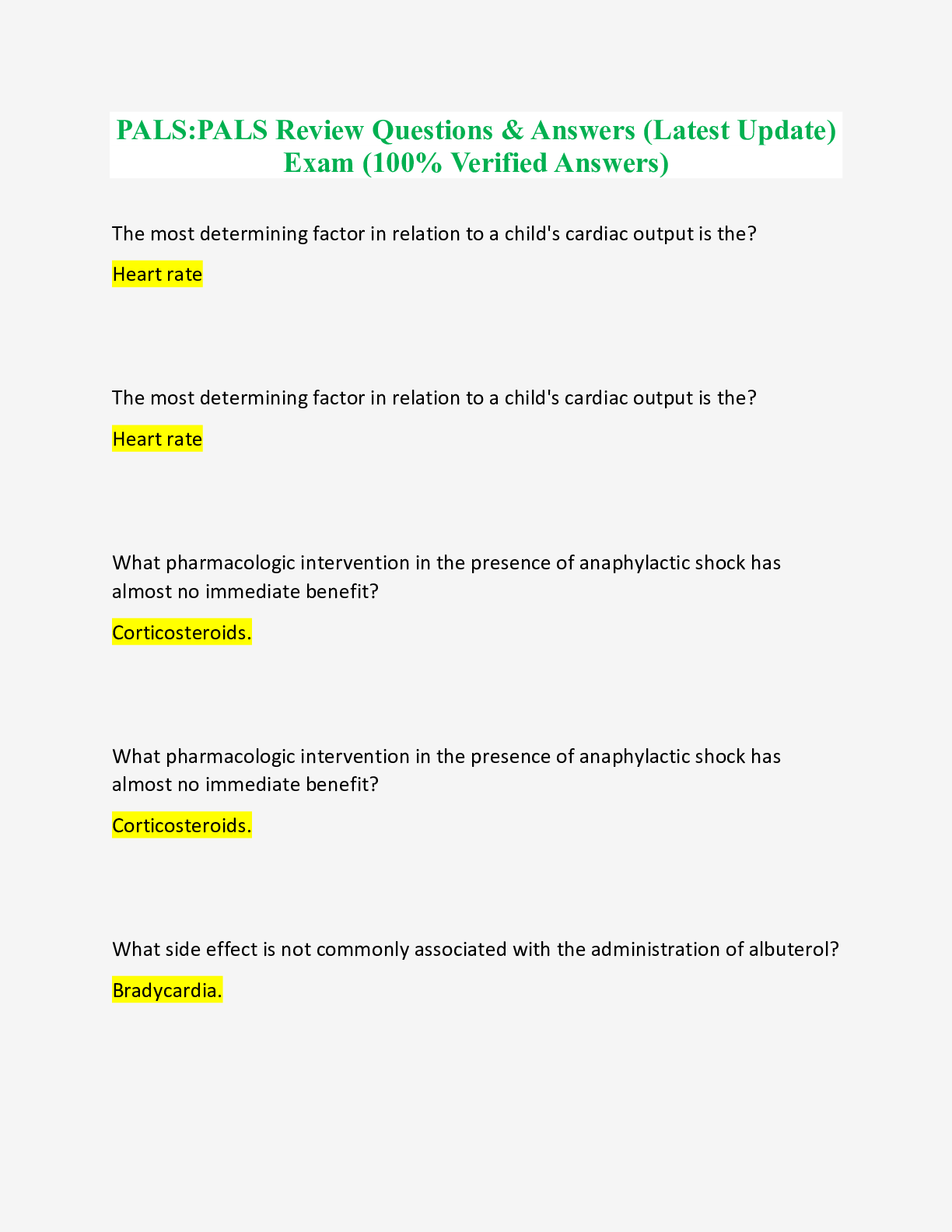
Buy this document to get the full access instantly
Instant Download Access after purchase
Buy NowInstant download
We Accept:

Also available in bundle (1)

PALS Final Exam: PALS Bundled Exams (100% Verified Answers) Latest Update 2023/2024
PALS Final Exam: PALS Bundled Exams (100% Verified Answers) Latest Update 2023/2024
By Goodluck Academia 2 years ago
$17
15
Reviews( 0 )
$9.00
Can't find what you want? Try our AI powered Search
Document information
Connected school, study & course
About the document
Uploaded On
Jul 12, 2023
Number of pages
39
Written in
Additional information
This document has been written for:
Uploaded
Jul 12, 2023
Downloads
0
Views
216

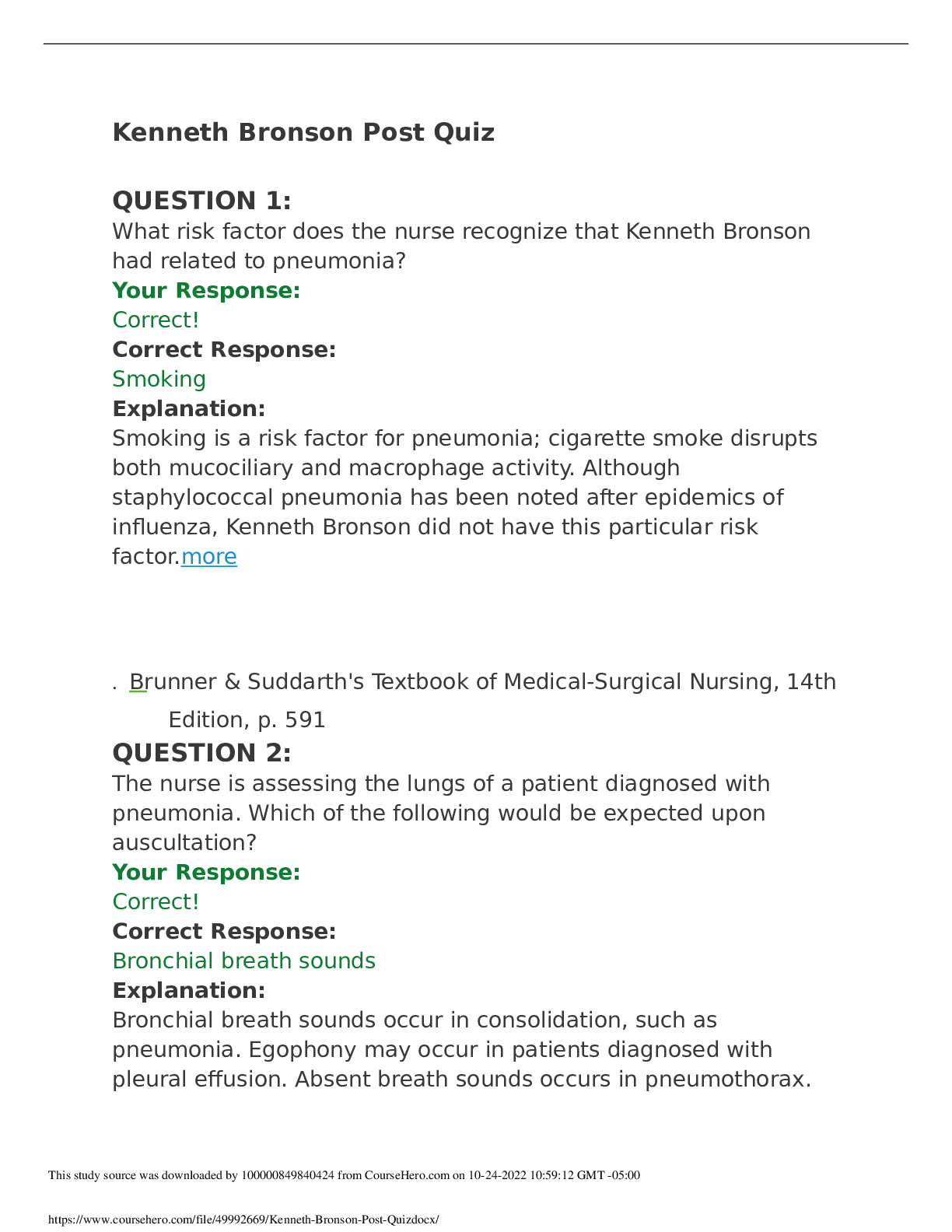



 Questions and Answers 100% VERIFIED.png)
 Questions and Answers 100% correct Solutions.png)



